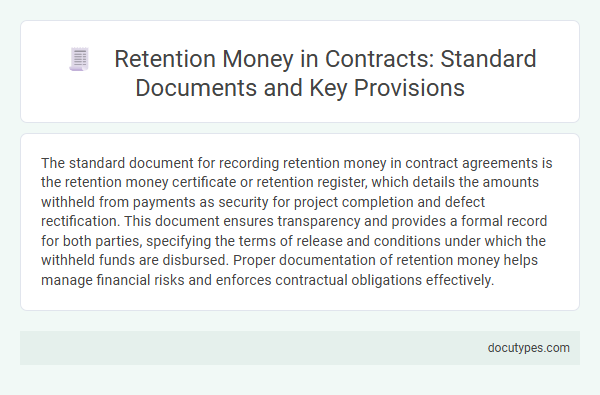The standard document for recording retention money in contract agreements is the retention money certificate or retention register, which details the amounts withheld from payments as security for project completion and defect rectification. This document ensures transparency and provides a formal record for both parties, specifying the terms of release and conditions under which the withheld funds are disbursed. Proper documentation of retention money helps manage financial risks and enforces contractual obligations effectively.
Introduction to Retention Money in Contracts
Retention money is a common practice in construction and service contracts designed to ensure the completion of work to the agreed standards. It acts as a financial safeguard, withholding a percentage of the payment until the project meets all specified requirements.
The standard document for recording retention money typically includes details such as the amount withheld, conditions for release, and timelines. You should ensure this document is clearly defined within your contract to manage expectations and protect your interests effectively.
Purpose and Importance of Retention Money
The standard document for recording retention money in contracts is typically the Retention Register or Retention Statement. This document tracks withheld payments to ensure project completion and quality assurance.
Retention money serves as a financial guarantee to encourage contractors to fulfill all obligations and rectify defects. It protects clients by withholding a portion of payment until the contract's terms are satisfactorily met. Accurate recording through the Retention Register ensures transparency and accountability in project management.
Legal Framework and Standard Contract Clauses
The standard document for recording retention money is typically embedded within the contract's legal framework to ensure compliance and clarity. Your contract should explicitly outline terms governing retention money to safeguard financial obligations.
- Legal Framework Compliance - Contracts reference statutes and regulations that dictate how retention money must be handled and recorded.
- Retention Clause Specification - Clear contract clauses define the amount, duration, and release conditions of retention money to avoid disputes.
- Documentation and Recordkeeping - Proper records are maintained as evidence of retention money held, protecting both parties' interests during the project lifecycle.
Key Provisions in Retention Money Agreements
The standard document for recording retention money in construction contracts is the Retention Money Agreement. This agreement outlines the terms for withholding and releasing retention funds to secure contract performance.
- Retention Amount - Specifies the percentage or sum of money withheld from payments as security.
- Release Conditions - Details the circumstances and timelines for releasing the retained funds.
- Dispute Resolution - Defines the procedure for resolving disagreements related to retention money.
Common Retention Money Percentages and Limits
The standard document for recording retention money in contracts is typically the Retention Agreement or a specific clause within the main contract. This document outlines the terms, percentage, and conditions for withholding payment to ensure project completion and quality.
Common retention money percentages range from 5% to 10% of the contract sum. Legal limits on retention money vary by jurisdiction but often cap the retention amount to protect both parties from excessive withholding.
Procedures for Release of Retention Money
The standard document for recording retention money in contracts is typically the Retention Register or Retention Schedule. This document tracks the amount withheld and conditions for its release throughout the project lifecycle.
- Retention Register - A formal record listing all retention amounts held against contract milestones or deliverables.
- Release Procedures - Defined steps outlining how and when retention money can be claimed or released to the contractor.
- Approval and Documentation - Release of retention money requires documented approval from authorized parties and proof of meeting contractual obligations.
Following the retention schedule and release procedures ensures transparency and protects interests of both clients and contractors.
Dispute Resolution Related to Retention Money
The standard document for recording retention money in contracts is the Retention Money Agreement or Clause within the main contract. This document outlines the terms, conditions, and the amount of money withheld to ensure project completion and defect rectification. Dispute resolution related to retention money is typically addressed through arbitration or mediation clauses specified within the agreement to protect your financial interests.
Retention Money in FIDIC and Other Standard Forms
Retention money is a common contractual mechanism used to ensure that contractors complete their obligations satisfactorily before final payment. In FIDIC contracts, retention money is typically held as a percentage of each payment certificate and released upon the completion of specific stages or after the defects liability period. Other standard forms, such as NEC and JCT, also incorporate retention clauses with variations in percentage and release conditions tailored to protect the client's interests in construction projects.
Risks and Best Practices for Managing Retention
What is the standard document for recording retention money in contracts? The standard document typically used is a Retention Register or Retention Schedule, which itemizes retained amounts and tracks their release. Proper documentation ensures clarity in financial management and reduces disputes between parties involved.
What risks are associated with managing retention money without proper documentation? Mismanagement can lead to delayed payments, potential legal disputes, and cash flow problems for contractors. Lack of transparency or accurate records increases the risk of misunderstandings or financial losses.
What are the best practices for managing retention money effectively? Maintaining an updated Retention Register, setting clear release criteria, and regularly communicating with stakeholders helps minimize risks. You should also ensure compliance with contract terms and promptly address any discrepancies to safeguard interests.
What Is the Standard Document for Recording Retention Money? Infographic

